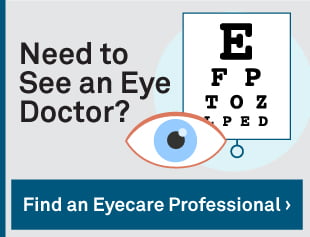Coronavirus (COVID-19) and your eyes? Respiratory droplets from coughs and sneezes are the main concern in the fight against coronavirus spread, but recent research shows the virus might also be transmitted through our eyes.
For that reason, some eye doctors, notably the American Academy of Ophthalmology, have suggested that eyeglasses might shield your eyes from the respiratory droplets spread when someone sneezes or coughs in your direction.
The Centers for Disease Control and Prevention (CDC) has stated that the spread of COVID-19 can occur when an unwashed hand comes in contact with the face. This allows the virus to spread through the mouth, nose and possibly the eyes.
It’s important to note that this is a much more uncommon method of transmission, but it shouldn’t diminish the importance of hand-washing and avoiding hand-to-face contact. Anything you can do to avoid the virus and “flatten the curve” is time well spent.

What is coronavirus?
Coronavirus, also referred to by its corresponding illness COVID-19, originated in Wuhan, China, in December 2019.
While there are actually many types of viruses that qualify as coronaviruses, the novel (new) coronavirus has proven to be an immediate threat to every country around the world.
COVID-19 can present with mild cold symptoms or more serious flu and respiratory symptoms, ranging from coughing, body aches and fever to bronchitis, pneumonia and kidney failure. More serious cases can be life-threatening.
An infected person can be asymptomatic (or presymptomatic), showing no noticeable symptoms at all, yet can still be contagious. The ease with which people are able to spread the virus, often without even realizing they’re sick, could be a big reason why the outbreak has been so difficult to contain.
Does COVID-19 cause any eye-related symptoms?
There has been some evidence that COVID-19 can produce eye-related symptoms, primarily in the form of conjunctivitis (also known as pink eye). Common signs of pink eye include eye redness, itchiness, and irritation, sometimes accompanied by discharge and eyelid crustiness.
Conjunctivitis can sometimes accompany a cold or flu, and it has also been noted in a small percentage of COVID-19 patients. In a study published in the New England Journal of Medicine, nine out of 1,009 infected patients in China—around 0.8%—also had conjunctivitis.
Additionally, the American Academy of Ophthalmology states that conjunctivitis could be seen in as many as 3% of COVID-infected patients.
Can coronavirus be transmitted through the eyes?
It’s likely that coronavirus can be transmitted through eyes, although we’re still learning a lot about how this virus operates.
According to the CDC, it’s entirely possible that someone can touch an object, moving the virus to the hand. Any hand-to-face contact can then transfer the virus to the face, where it can enter through facial mucous membranes such as the mouth, nose, and eyes.
However, the health agency stresses that this probably isn’t the main way coronavirus spreads. Far and away, it is believed to be spread when respiratory droplets (in the air after a person coughs or sneezes) enter the nose or mouth of a person less than six feet away.
How contagious is COVID-19?
The CDC notes that the coronavirus spreads “easily and sustainably” within communities.
“Easily” means it can be transmitted quickly from one person to another, while “sustainably” signals that it sticks around and continues to spread once it’s made it into a community.
The ease and sustainability of COVID-19 transmission are the primary reasons so many local, state and federal government officials are urging Americans to socially distance themselves and stay at home as much as possible.
How can I avoid contracting or transmitting COVID-19?
As you’ve probably heard, there are several easy steps you can take to lower your chances of contracting coronavirus — and passing it on to others. The CDC maintains an updated coronavirus prevention guide for all current recommendations. Recommenations include:
Wash your hands frequently
- Stick by the 20-second hand-washing rule, making sure you thoroughly wash every part of your hands with soap and water. (pro tip: singing “Happy Birthday” is roughly 20-seconds long)
- Hand sanitizer can be used as an alternative, although soap and water are preferred. Sanitizer should include at least 60% alcohol or higher. Make sure you cover every part of your hands, then rub them together until they’re dry.
- Avoid touching your eyes, mouth, and nose — especially when you haven’t washed your hands.
Avoid close contact
- Keep your distance from people who appear visibly sick.
- Keep your distance from everybody if community spread has started where you live. People who are at higher risk for complications should exercise even more caution.
Stay at home if you’re feeling sick
- The CDC suggests staying strictly indoors if you feel any symptoms, with the only exception being traveling to get medical care. And, if you feel sick enough to seek medical care, call your doctor first to let them know you’re coming.
Cover your mouth when you cough or sneeze
- If you don’t have a tissue, cough or sneeze into the inside of your elbow.
- Do not reuse tissues — throw them away after each use.
- Follow the hand-washing or sanitizing guidelines immediately after coughing or sneezing.
If you’re sick, wear a face mask around other people
- This applies to any time you enter a room, vehicle or health care provider’s office. If you can’t wear a face mask, ensure you’re properly distanced and do as much as you can to cover your coughs and sneezes. When other people are caring for you, they should be wearing a face mask around you as well.
- If you aren’t sick, you don’t need to wear a face mask unless you are caring for a sick person. Saving face masks for caregivers — especially health care workers — is critical during this period of shortage.
Clean your surroundings
- Surfaces that are touched often should be cleaned and disinfected daily (at a minimum). Examples include tables, countertops, doorknobs, light switches, handles, phones, keyboards, toilets, and sinks.
- If a surface is already dirty, clean it with soap and water first, then disinfect it.
More information on store-bought disinfectants, how to make your own, and proper ventilation can be found in the CDC guide.





0 Comments